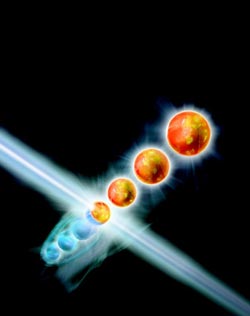Competition in the Quantum World

The physicists engineer a classical environment, which generates dissipative dynamics, leading to fragile long-range quantum mechanical correlations between distant particles.<br>IQOQI/Ritsch<br>
They are the first scientists that simulated the competition between two rival dynamical processes at a novel type of transition between two quantum mechanical orders. They have published the results of their work in the journal Nature Physics.
“When water boils, its molecules are released as vapor. We call this change of the physical state of matter a phase transition,” explains Sebastian Diehl from the Institute of Theoretical Physics at the University of Innsbruck. Together with his colleagues from the Institute for Experimental Physics and the theorist Markus Mueller from the Complutense University of Madrid, he studied the transition between two quantum mechanical orders in a way never before observed. The quantum physicists in Innsbruck use a new device for the experiment, which is currently considered to be one of the most promising developments in quantum physics: a quantum simulator. It is based on a small-scale quantum computer and can simulate physical phenomena a classical computer cannot investigate efficiently. “Such a quantum simulator allows us to experimentally study quantum phenomena in many-body systems that are coupled to their environment,” explain experimental physicists Philipp Schindler and Thomas Monz.
Observing the competition
With just a few trapped ions the scientists simulate the complex physical processes of quantum mechanical phase transitions. To achieve this, they have to manipulate and control the particles with high accuracy; the experimental physicists in Innsbruck are world leaders in this field. “For this experiment we use a programmable quantum simulator with up to five ions,” says Philipp Schindler. One of the particles is used as a means to couple the system to the classical environment in a controlled manner. The other ions are used for carrying out quantum operations. “We call this an open quantum simulator. Usually we want to suppress this coupling because it destroys the fragile quantum effects in the system. Here, however, we use it to bring order into the quantum mechanical system,” explains Schindler. “In our specific case, we engineer a classical environment, which generates dissipative dynamics, leading to fragile long-range quantum mechanical correlations between distant particles.” In the following step, this dynamics is then set in competition with a different type of interactions, which interrupts the dynamics that create the quantum mechanical order. “By doing this, we are able to observe how the competition between these two processes takes place and what precisely occurs right at the transition between two distinct orders of matter,” explains theoretical physicist Sebastian Diehl.
Error reduction
The experiment demands an enormous degree of precision, which requires immediate error corrections to be able to simulate the physical processes correctly. Since a comprehensive error correction, as developed for quantum computers, involves considerable resource overheads, the physicists in Innsbruck chose another promising alternative path. They identified the most important sources of error occurring during the simulation and specifically targeted them. Schindler is convinced: “This way of error reduction will surely set an example for other experiments. While general quantum error correction remains a long-term goal, we may be able to successfully use this type of error correction a lot sooner for reliable quantum simulation of larger systems,” adds Markus Mueller.
Interweaving theory with experiment
Such an experimental study of the nature of quantum mechanical phase transitions is internationally unique. It was only possible because advanced experimental know-how was successfully combined with theoretical research, which was carried out in close collaboration between physicists from Innsbruck and Madrid. “This link between theoretical and experimental physicists who work closely together, and in Innsbruck under one roof, is possible in very few places. It is also one of the great strengths of quantum physics research carried out in Innsbruck. And this research, once again, led us into an area of physics that hadn’t been explored before,” says Rainer Blatt. “In this experiment the physics of many-body systems is successfully simulated with a few trapped ions. This clearly shows the potential and the possibilities of quantum simulation,” adds Peter Zoller.
Publication: Quantum simulation of dynamical maps with trapped ions. P. Schindler, M. Müller, D. Nigg, J. T. Barreiro, E. A. Martinez, M. Hennrich, T. Monz, S. Diehl, P. Zoller und R. Blatt, Advance online publication, Nature Physics am 19. Mai 2013 DOI: 10.1038/NPHYS2630
Contact:
Philipp Schindler
Institute for Experimental Physics
University of Innsbruck
Phone: +43 512 507-52453
Email: philipp.schindler@uibk.ac.at
Christian Flatz
Public Relations
University of Innsbruck
Phone: +43 512 507-32022
Cell: +43 676 872532022
Email: christian.flatz@uibk.ac.at
Weitere Informationen:
http://dx.doi.org/10.1038/NPHYS2630
– Quantum simulation of dynamical maps with trapped ions. P. Schindler, M. Müller, D. Nigg, J. T. Barreiro, E. A. Martinez, M. Hennrich, T. Monz, S. Diehl, P. Zoller und R. Blatt, Advance online publication, Nature Physics on May 19, 2013
http://www.quantumoptics.at
– Quantum Optics and Spectroscopy
Media Contact
All latest news from the category: Physics and Astronomy
This area deals with the fundamental laws and building blocks of nature and how they interact, the properties and the behavior of matter, and research into space and time and their structures.
innovations-report provides in-depth reports and articles on subjects such as astrophysics, laser technologies, nuclear, quantum, particle and solid-state physics, nanotechnologies, planetary research and findings (Mars, Venus) and developments related to the Hubble Telescope.
Newest articles

Silicon Carbide Innovation Alliance to drive industrial-scale semiconductor work
Known for its ability to withstand extreme environments and high voltages, silicon carbide (SiC) is a semiconducting material made up of silicon and carbon atoms arranged into crystals that is…

New SPECT/CT technique shows impressive biomarker identification
…offers increased access for prostate cancer patients. A novel SPECT/CT acquisition method can accurately detect radiopharmaceutical biodistribution in a convenient manner for prostate cancer patients, opening the door for more…

How 3D printers can give robots a soft touch
Soft skin coverings and touch sensors have emerged as a promising feature for robots that are both safer and more intuitive for human interaction, but they are expensive and difficult…





















